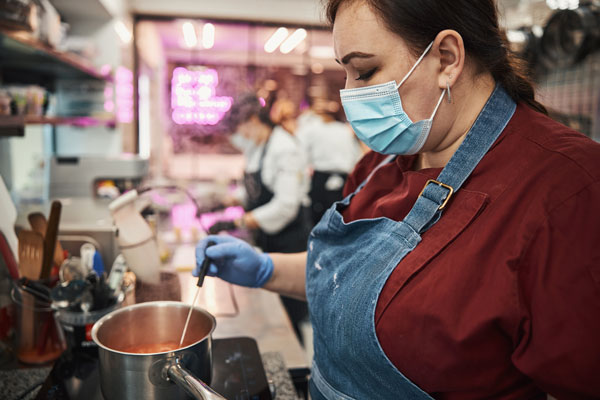Sanitation, Sanitation, Where Art Thou?
Continuing the theme I picked up on a few months ago, discussing common causes of foodborne illness, I’d like to focus this blog on cross contamination, more precisely sanitation. Sanitation is another issue that employees don’t often do at home, so they discount the importance of it in the food production environment. That is to say that they have never made someone sick at home because they only clean their countertops and they have likely never sanitized their kitchen, so why is it so important in a foodservice facility?
If you want to see how seriously your employees take sanitation, look no further than the first thing they do when they start production in the morning. Do employees start food production upon first arriving in the morning or do they take time to sanitize all the work surfaces before starting production? This may seem like an unnecessary step, especially in operations where there may only be one production shift, like in a school system. However, you can never really be too sure of what occurred during the evening when no one was using the space. Was a maintenance person working in the area with their work bag on the table? Did an after-hours delivery drive place boxes that were sitting outside on the ground on the preparation table? Did a rodent or cockroach (although we hate to think of this – it does happen) run across the table in the wee hours of the morning? Or perhaps the staff the day before didn’t really sanitize as well as they had thought they did.
If you want to see how seriously your employees take sanitation, look no further than the first thing they do when they start production in the morning…do they take time to sanitize all the work surfaces before starting production?
Often, our employees like to show off their clean kitchens, and certainly a clean kitchen is something to be proud of. Afterall, it cannot be sanitized if it is not first clean. However, we must be sure to educate our employees that we cannot stop at clean. We must be mindful to sanitize property and avoid cross contamination. A few years ago, we placed a camera in a school to watch sanitation practices and were surprised as what we found at the end of the day. We’ve released the video and use it in training to help employees understand the importance of cleaning vs. sanitizing and have made it available online free of charge.
Be certain your employees are also aware of the sanitizer you use in your facility –on surfaces and within the three-compartment sink and/or dishwasher. They need to know what product to use, but also the specifics about the product – how to mix it, proper strength, the amount of contact time for it to be effective, and how to properly utilize test strips to ensure that the concentration is correct.
Once you are sure your employees are knowledgeable about your sanitizers, the tricky part is ensuring that they use them when they are supposed to do so. This is again where that culture of food safety comes into play. As a manager, you cannot be everywhere all the time, so you must have a supportive environment where employees are able to remind other employees to properly sanitize surfaces or equipment when they see that it has not been done correctly. Allowing all employees to hold each other accountable in a supportive environment will go a long way to not only providing the safe food culture, but also ensuring guest satisfaction and safety throughout your organization.
Late last week, we released our second SafeBites Webinar of 2022. In the webinar, Dr. Ellen Shumaker, who directs the outreach and extension activities for the Safe Plates program at North Carolina State University, discusses food safety messaging and the role of food safety culture in shaping employee and organizational behaviors. This is the second release of our new on-demand webinar, please drop me a note and let me know if you enjoy the new format or not. Risk Nothing.
READ MORE POSTS
Food Traceability in Foodservice Operations: An Essential, and Soon-to-be Required, Component of your Food Safety Plan
In June, I discussed the importance of having a solid food defense plan, and I provided you some resources for developing or strengthening your food defense plan. As I was writing those blogs, my mind kept turning toward food traceability. While they are distinctly different concepts, food traceability goes hand-in-hand with a food defense program. I would argue for your food defense plan to be effective, you must have an effective internal food traceability program, where you can trace the product back to the supplier (backward traceability), but also be able to trace the product from the supplier to the guest who was served the product (forward traceability).
Food Defense Plan Resources – at just the right price…
Earlier in the month, I discussed the importance of having a solid food defense plan in place for your foodservice operation. Even if the first version of your plan is not perfect, it is a start. Having plans down on paper will force you to think through the process and ensure the vulnerable points where opportunities exist for possible contamination within the operation are mitigated.
Don’t Turn a Blind Eye to Your Food Defense Practices
Late last week, as I mindlessly scrolled through Twitter, I ran across a Tweet suggesting the #IceCreamChallenge from summer 2019 was the real cause of the Coronavirus spread. Of course, the Tweet was made tongue in cheek, but it did cause me to reflect on that challenge, which had a short life on social media in the summer of 2019.
Salmonella and Listeria monocytogenes: Serious Threats to the Safety of Food
Earlier in the month, I mentioned the top microbial enemies we all face in foodservice operations, E. coli, Campylobacter, Salmonella, and Listeria monocytogenes. While we discussed E. coli and Campylobacter, we did not get around to discussing Salmonella or Listeria monocytogenes.










